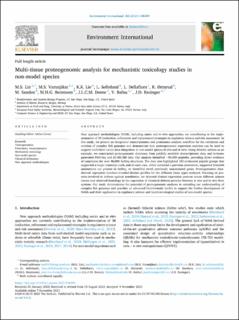| dc.contributor.author | Lin, M.S. | |
| dc.contributor.author | Varunjikar, Madhushri Shrikant | |
| dc.contributor.author | Lie, Kai Kristoffer | |
| dc.contributor.author | Søfteland, Liv Ingeborg Rosvoll | |
| dc.contributor.author | Dellafiora, L. | |
| dc.contributor.author | Ørnsrud, Robin | |
| dc.contributor.author | Sanden, Monica | |
| dc.contributor.author | Berntssen, Marc HG | |
| dc.contributor.author | Dorne, J.L.C.M. | |
| dc.contributor.author | Bafna, V. | |
| dc.contributor.author | Rasinger, Josef | |
| dc.date.accessioned | 2023-12-07T13:52:48Z | |
| dc.date.available | 2023-12-07T13:52:48Z | |
| dc.date.created | 2023-12-04T13:30:35Z | |
| dc.date.issued | 2023 | |
| dc.identifier.citation | Environment International. 2023, 182 . | |
| dc.identifier.issn | 0160-4120 | |
| dc.identifier.uri | https://hdl.handle.net/11250/3106445 | |
| dc.description.abstract | New approach methodologies (NAM), including omics and in vitro approaches, are contributing to the implementation of 3R (reduction, refinement and replacement) strategies in regulatory science and risk assessment. In this study, we present an integrative transcriptomics and proteomics analysis workflow for the validation and revision of complex fish genomes and demonstrate how proteogenomics expression matrices can be used to support multi-level omics data integration in non-model species in vivo and in vitro. Using Atlantic salmon as an example, we constructed proteogenomic databases from publicly available transcriptomic data and in-house generated RNA-Seq and LC-MS/MS data. Our analysis identified ∼80,000 peptides, providing direct evidence of translation for over 40,000 RefSeq structures. The data also highlighted 183 co-located peptide groups that supported a single transcript each, and in each case, either corrected a previous annotation, supported Ensembl annotations not present in RefSeq, or identified novel previously unannotated genes. Proteogenomics data-derived expression matrices revealed distinct profiles for the different tissue types analyzed. Focusing on proteins involved in defense against xenobiotics, we detected distinct expression patterns across different salmon tissues and observed homology in the expression of chemical defense proteins between in vivo and in vitro liver systems. Our study demonstrates the potential of proteogenomic analyses in extending our understanding of complex fish genomes and provides an advanced bioinformatic toolkit to support the further development of NAMs and their application in regulatory science and (eco)toxicological studies of non-model species. | |
| dc.language.iso | eng | |
| dc.title | Multi-tissue proteogenomic analysis for mechanistic toxicology studies in non-model species | |
| dc.title.alternative | Multi-tissue proteogenomic analysis for mechanistic toxicology studies in non-model species | |
| dc.type | Peer reviewed | |
| dc.type | Journal article | |
| dc.description.version | publishedVersion | |
| dc.source.pagenumber | 13 | |
| dc.source.volume | 182 | |
| dc.source.journal | Environment International | |
| dc.identifier.doi | 10.1016/j.envint.2023.108309 | |
| dc.identifier.cristin | 2208506 | |
| dc.relation.project | Norges forskningsråd: 281032 | |
| dc.relation.project | Norges forskningsråd: 254807 | |
| dc.relation.project | Norges forskningsråd: 15804 | |
| dc.relation.project | Norges forskningsråd: 268088 | |
| dc.relation.project | Havforskningsinstituttet: 15470 | |
| cristin.ispublished | true | |
| cristin.fulltext | original | |
| cristin.qualitycode | 1 | |
